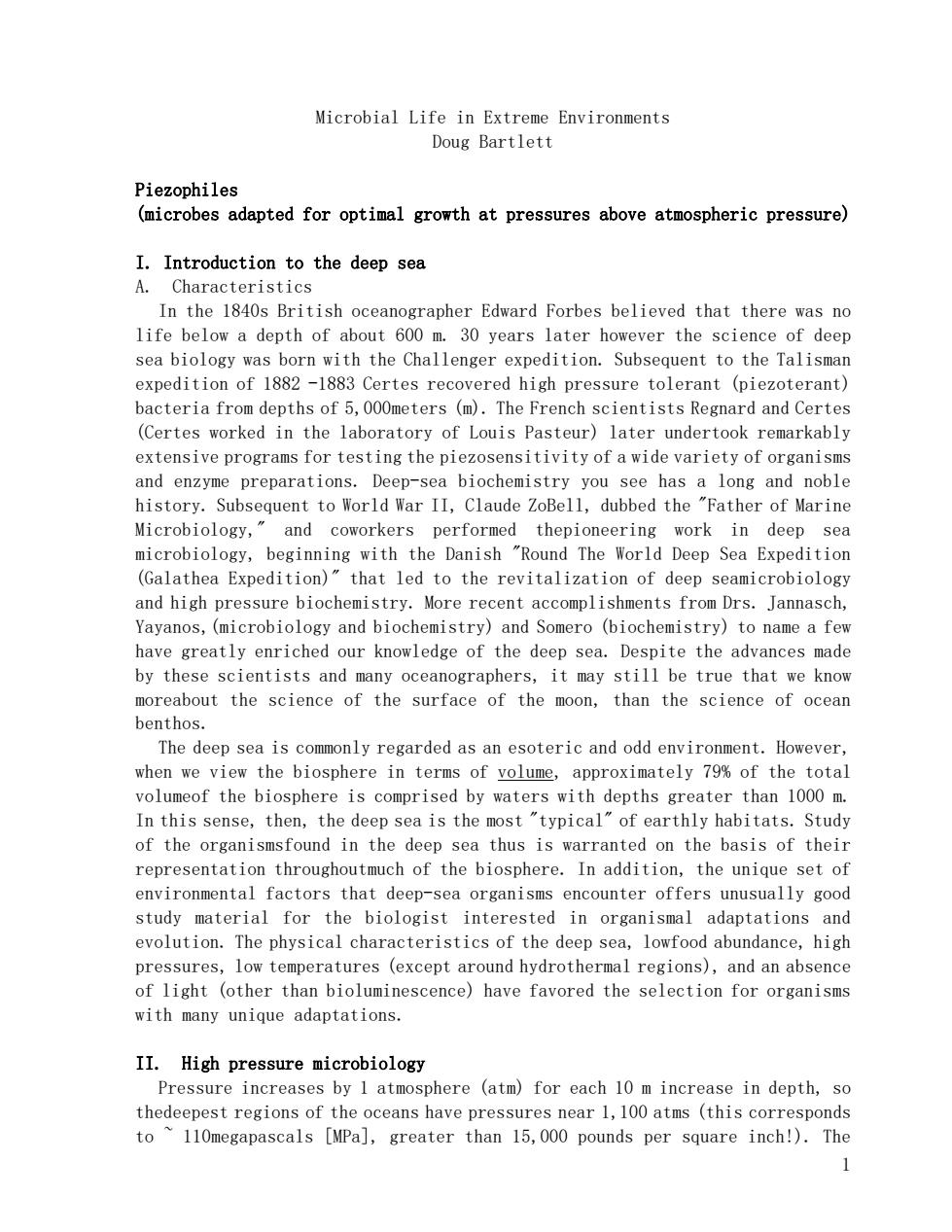
Microbial Life in Extreme Environments Doug Bartlett Piezophiles (microbes adapted for optimal growth at pressures above atmospheric pressure) I.Introduction to the deep sea A.Characteristics In the 1840s British oceanographer Edward Forbes believed that there was no life below a depth of about 600 m.30 years later however the science of deep sea biology was born with the Challenger expedition.Subsequent to the Talisman expedition of 1882-1883 Certes recovered high pressure tolerant (piezoterant) bacteria from depths of 5,000meters (m).The French scientists Regnard and Certes (Certes worked in the laboratory of Louis Pasteur)later undertook remarkably extensive programs for testing the piezosensitivity of a wide variety of organisms and enzyme preparations.Deep-sea biochemistry you see has a long and noble history.Subsequent to World War II,Claude ZoBell,dubbed the "Father of Marine Microbiology,"and coworkers performed thepioneering work in deep sea microbiology,beginning with the Danish "Round The World Deep Sea Expedition (Galathea Expedition)"that led to the revitalization of deep seamicrobiology and high pressure biochemistry.More recent accomplishments from Drs.Jannasch, Yayanos,(microbiology and biochemistry)and Somero (biochemistry)to name a few have greatly enriched our knowledge of the deep sea.Despite the advances made by these scientists and many oceanographers,it may still be true that we know moreabout the science of the surface of the moon,than the science of ocean benthos. The deep sea is commonly regarded as an esoteric and odd environment.However, when we view the biosphere in terms of volume,approximately 79%of the total volumeof the biosphere is comprised by waters with depths greater than 1000 m. In this sense,then,the deep sea is the most "typical"of earthly habitats.Study of the organismsfound in the deep sea thus is warranted on the basis of their representation throughoutmuch of the biosphere.In addition,the unique set of environmental factors that deep-sea organisms encounter offers unusually good study material for the biologist interested in organismal adaptations and evolution.The physical characteristics of the deep sea,lowfood abundance,high pressures,low temperatures (except around hydrothermal regions),and an absence of light (other than bioluminescence)have favored the selection for organisms with many unique adaptations. II.High pressure microbiology Pressure increases by 1 atmosphere (atm)for each 10 m increase in depth,so thedeepest regions of the oceans have pressures near 1,100 atms (this corresponds to 110megapascals [MPa],greater than 15,000 pounds per square inch!).The 1
1 Microbial Life in Extreme Environments Doug Bartlett Piezophiles (microbes adapted for optimal growth at pressures above atmospheric pressure) I. Introduction to the deep sea A. Characteristics In the 1840s British oceanographer Edward Forbes believed that there was no life below a depth of about 600 m. 30 years later however the science of deep sea biology was born with the Challenger expedition. Subsequent to the Talisman expedition of 1882 -1883 Certes recovered high pressure tolerant (piezoterant) bacteria from depths of 5,000meters (m). The French scientists Regnard and Certes (Certes worked in the laboratory of Louis Pasteur) later undertook remarkably extensive programs for testing the piezosensitivity of a wide variety of organisms and enzyme preparations. Deep-sea biochemistry you see has a long and noble history. Subsequent to World War II, Claude ZoBell, dubbed the "Father of Marine Microbiology," and coworkers performed thepioneering work in deep sea microbiology, beginning with the Danish "Round The World Deep Sea Expedition (Galathea Expedition)" that led to the revitalization of deep seamicrobiology and high pressure biochemistry. More recent accomplishments from Drs. Jannasch, Yayanos,(microbiology and biochemistry) and Somero (biochemistry) to name a few have greatly enriched our knowledge of the deep sea. Despite the advances made by these scientists and many oceanographers, it may still be true that we know moreabout the science of the surface of the moon, than the science of ocean benthos. The deep sea is commonly regarded as an esoteric and odd environment. However, when we view the biosphere in terms of volume, approximately 79% of the total volumeof the biosphere is comprised by waters with depths greater than 1000 m. In this sense, then, the deep sea is the most "typical" of earthly habitats. Study of the organismsfound in the deep sea thus is warranted on the basis of their representation throughoutmuch of the biosphere. In addition, the unique set of environmental factors that deep-sea organisms encounter offers unusually good study material for the biologist interested in organismal adaptations and evolution. The physical characteristics of the deep sea, lowfood abundance, high pressures, low temperatures (except around hydrothermal regions), and an absence of light (other than bioluminescence) have favored the selection for organisms with many unique adaptations. II. High pressure microbiology Pressure increases by 1 atmosphere (atm) for each 10 m increase in depth, so thedeepest regions of the oceans have pressures near 1,100 atms (this corresponds to ~ 110megapascals [MPa], greater than 15,000 pounds per square inch!). The
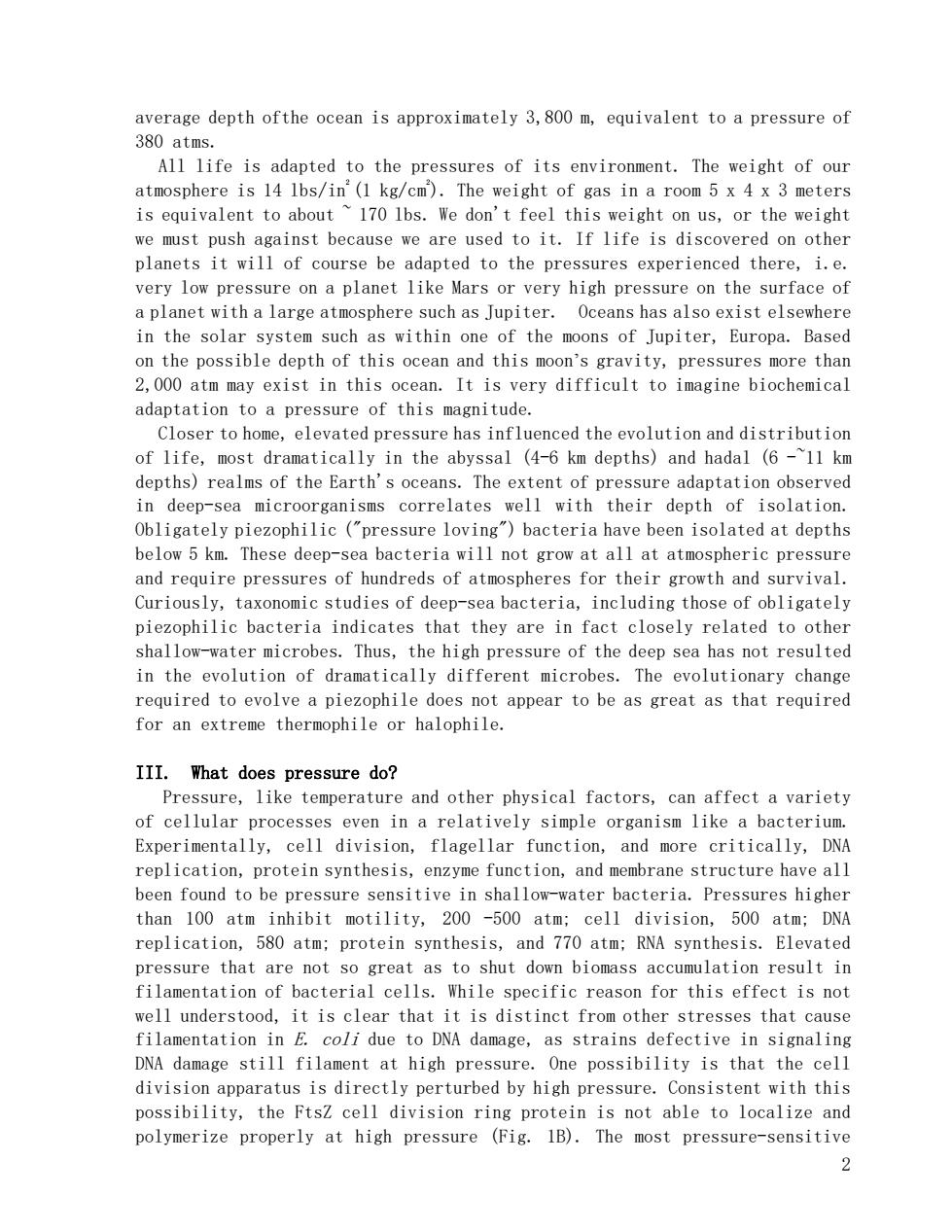
average depth ofthe ocean is approximately 3,800 m,equivalent to a pressure of 380 atms. All life is adapted to the pressures of its environment.The weight of our atmosphere is 14 lbs/in'(1 kg/cm).The weight of gas in a room 5 x 4 x 3 meters is equivalent to about 170 lbs.We don't feel this weight on us,or the weight we must push against because we are used to it.If life is discovered on other planets it will of course be adapted to the pressures experienced there,i.e. very low pressure on a planet like Mars or very high pressure on the surface of a planet with a large atmosphere such as Jupiter.Oceans has also exist elsewhere in the solar system such as within one of the moons of Jupiter,Europa.Based on the possible depth of this ocean and this moon's gravity,pressures more than 2,000 atm may exist in this ocean.It is very difficult to imagine biochemical adaptation to a pressure of this magnitude. Closer to home,elevated pressure has influenced the evolution and distribution of life,most dramatically in the abyssal (4-6 km depths)and hadal (6-11 km depths)realms of the Earth's oceans.The extent of pressure adaptation observed in deep-sea microorganisms correlates well with their depth of isolation. Obligately piezophilic ("pressure loving)bacteria have been isolated at depths below 5 km.These deep-sea bacteria will not grow at all at atmospheric pressure and require pressures of hundreds of atmospheres for their growth and survival. Curiously,taxonomic studies of deep-sea bacteria,including those of obligately piezophilic bacteria indicates that they are in fact closely related to other shallow-water microbes.Thus,the high pressure of the deep sea has not resulted in the evolution of dramatically different microbes.The evolutionary change required to evolve a piezophile does not appear to be as great as that required for an extreme thermophile or halophile. III.What does pressure do? Pressure,like temperature and other physical factors,can affect a variety of cellular processes even in a relatively simple organism like a bacterium. Experimentally,cell division,flagellar function,and more critically,DNA replication,protein synthesis,enzyme function,and membrane structure have all been found to be pressure sensitive in shallow-water bacteria.Pressures higher than 100 atm inhibit motility,200 -500 atm;cell division,500 atm;DNA replication,580 atm;protein synthesis,and 770 atm;RNA synthesis.Elevated pressure that are not so great as to shut down biomass accumulation result in filamentation of bacterial cells.While specific reason for this effect is not well understood,it is clear that it is distinct from other stresses that cause filamentation in E.coli due to DNA damage,as strains defective in signaling DNA damage still filament at high pressure.One possibility is that the cell division apparatus is directly perturbed by high pressure.Consistent with this possibility,the FtsZ cell division ring protein is not able to localize and polymerize properly at high pressure (Fig.IB).The most pressure-sensitive 2
2 average depth ofthe ocean is approximately 3,800 m, equivalent to a pressure of 380 atms. All life is adapted to the pressures of its environment. The weight of our atmosphere is 14 lbs/in 2 (1 kg/cm 2). The weight of gas in a room 5 x 4 x 3 meters is equivalent to about ~ 170 lbs. We don't feel this weight on us, or the weight we must push against because we are used to it. If life is discovered on other planets it will of course be adapted to the pressures experienced there, i.e. very low pressure on a planet like Mars or very high pressure on the surface of a planet with a large atmosphere such as Jupiter. Oceans has also exist elsewhere in the solar system such as within one of the moons of Jupiter, Europa. Based on the possible depth of this ocean and this moon’s gravity, pressures more than 2,000 atm may exist in this ocean. It is very difficult to imagine biochemical adaptation to a pressure of this magnitude. Closer to home, elevated pressure has influenced the evolution and distribution of life, most dramatically in the abyssal (4-6 km depths) and hadal (6 -~11 km depths) realms of the Earth's oceans. The extent of pressure adaptation observed in deep-sea microorganisms correlates well with their depth of isolation. Obligately piezophilic ("pressure loving") bacteria have been isolated at depths below 5 km. These deep-sea bacteria will not grow at all at atmospheric pressure and require pressures of hundreds of atmospheres for their growth and survival. Curiously, taxonomic studies of deep-sea bacteria, including those of obligately piezophilic bacteria indicates that they are in fact closely related to other shallow-water microbes. Thus, the high pressure of the deep sea has not resulted in the evolution of dramatically different microbes. The evolutionary change required to evolve a piezophile does not appear to be as great as that required for an extreme thermophile or halophile. III. What does pressure do? Pressure, like temperature and other physical factors, can affect a variety of cellular processes even in a relatively simple organism like a bacterium. Experimentally, cell division, flagellar function, and more critically, DNA replication, protein synthesis, enzyme function, and membrane structure have all been found to be pressure sensitive in shallow-water bacteria. Pressures higher than 100 atm inhibit motility, 200 -500 atm; cell division, 500 atm; DNA replication, 580 atm; protein synthesis, and 770 atm; RNA synthesis. Elevated pressure that are not so great as to shut down biomass accumulation result in filamentation of bacterial cells. While specific reason for this effect is not well understood, it is clear that it is distinct from other stresses that cause filamentation in E. coli due to DNA damage, as strains defective in signaling DNA damage still filament at high pressure. One possibility is that the cell division apparatus is directly perturbed by high pressure. Consistent with this possibility, the FtsZ cell division ring protein is not able to localize and polymerize properly at high pressure (Fig. 1B). The most pressure-sensitive

structure known is that of the gas vesicle.Gas vesicle membranes can collapse at pressures as low as 0.06 MPa (equal to 6 meters depth). Elevated pressure also has commercial applications.High pressures [hundreds of megapascals,1 megapascal (MPa)9.9 atmospheres 10 bar]can be used in place of temperature for food pasteurization,in which case there is less of an effect on food color or flavor.High pressure is also used for food processing, where it can be used to form gels,promote protein coagulation,or lipid phase transitions.Also,because pressure influences enzyme reactions in ways that are very different from osmotic pressure or temperature effects,there is interest in obtaining piezophilic derivatives of yeast and antibiotic producing bacteria to alter fermentation products for food and natural product formation, respectively. During the normal activity of humans there are tissues,particularly the cartilage of our joints,which routinely experience considerable hydrostatic pressure. Indeed these pressures or loads on our joints are important for human health (this is one of the reasons astronauts experiencing weightlessness for prolonged periods can suffer health problems).Simply standing can result in 20 MPa pressure in the human hip.Even we terrestrial mammals are all piezophiles to some extent! A.Pressure effects are related to volume changes Pressure changes will affect any biological process that occurs with a change in system volume.Intuitively this should be clear.For example,if a volume expansion must accompany a process,e.g.,adding gas to a fish's swim bladder to increase theorgan's volume,this process will be more difficult under higher pressure.Conversely,if a decrease in volume accompanies a process,then elevated pressure will favor the process. These intuitively obvious relationships can be expressed mathematically as follows: 1)KK exp(-PAV/RT)and 2)k =k exp(-PAV /RT) These two equations express the relationship of either the equilibrium constant (K)or rate constant (k)of a reaction to pressure,as determined by the size of the volume change that takes place during either the establishment of equilibrium (AV)or the formation of the activated complex (AV).K and k are the equilibrium and rate constants,respectively, at 1 atmosphere (atm)pressure;K and k are the constants at a higher pressure, p.R is the gas constant and T is absolute temperature.Equilibrium constants,unlike rate constants,are also dependent on the concentration of substrates and products. For example,proteins whose polymerization are sensitive to high pressure at one 3
3 structure known is that of the gas vesicle. Gas vesicle membranes can collapse at pressures as low as 0.06 MPa (equal to 6 meters depth). Elevated pressure also has commercial applications. High pressures [hundreds of megapascals, 1 megapascal (MPa) ≈ 9.9 atmospheres = 10 bar] can be used in place of temperature for food pasteurization, in which case there is less of an effect on food color or flavor. High pressure is also used for food processing, where it can be used to form gels, promote protein coagulation, or lipid phase transitions. Also, because pressure influences enzyme reactions in ways that are very different from osmotic pressure or temperature effects, there is interest in obtaining piezophilic derivatives of yeast and antibiotic producing bacteria to alter fermentation products for food and natural product formation, respectively. During the normal activity of humans there are tissues, particularly the cartilage of our joints, which routinely experience considerable hydrostatic pressure. Indeed these pressures or loads on our joints are important for human health (this is one of the reasons astronauts experiencing weightlessness for prolonged periods can suffer health problems). Simply standing can result in 20 MPa pressure in the human hip. Even we terrestrial mammals are all piezophiles to some extent! A. Pressure effects are related to volume changes Pressure changes will affect any biological process that occurs with a change in system volume. Intuitively this should be clear. For example, if a volume expansion must accompany a process, e.g., adding gas to a fish's swim bladder to increase theorgan's volume, this process will be more difficult under higher pressure. Conversely, if a decrease in volume accompanies a process, then elevated pressure will favor the process. These intuitively obvious relationships can be expressed mathematically as follows: 1) K p = K 1 exp(-P∆V/RT) and 2) k p = k 1 exp(-P∆V † /RT) These two equations express the relationship of either the equilibrium constant (K) or rate constant (k) of a reaction to pressure, as determined by the size of the volume change that takes place during either the establishment of equilibrium (∆V) or the formation of the activated complex (∆V † ). K 1 and k 1 are the equilibrium and rate constants, respectively, at 1 atmosphere (atm) pressure; K p and k p are the constants at a higher pressure, p. R is the gas constant and T is absolute temperature. Equilibrium constants, unlike rate constants, are also dependent on the concentration of substrates and products. For example, proteins whose polymerization are sensitive to high pressure at one
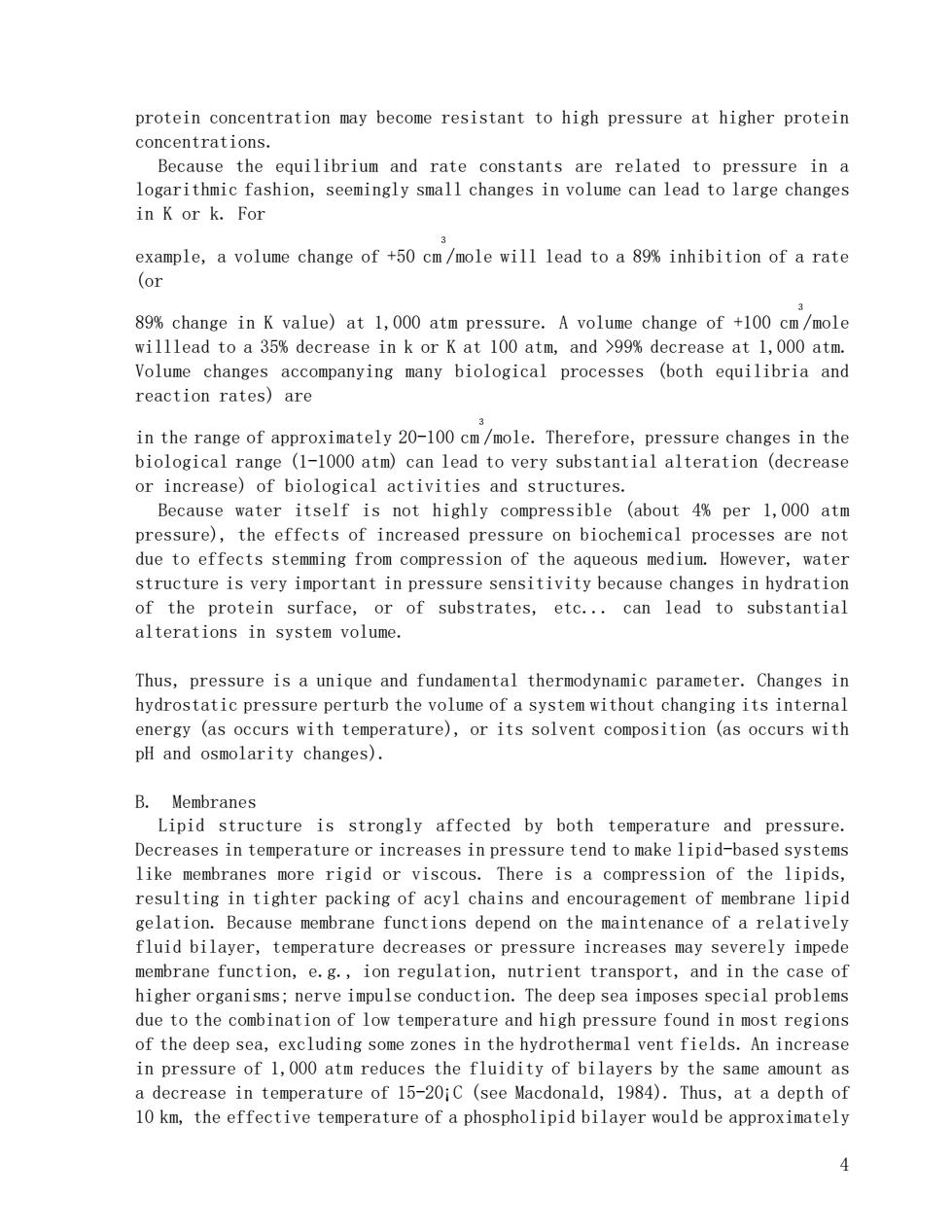
protein concentration may become resistant to high pressure at higher protein concentrations. Because the equilibrium and rate constants are related to pressure in a logarithmic fashion,seemingly small changes in volume can lead to large changes in K or k.For example,a volume change of +50 cm/mole will lead to a 89%inhibition of a rate (or 89%change in K value)at 1,000 atm pressure.A volume change of +100 cm/mole willlead to a 35%decrease in k or K at 100 atm,and >99%decrease at 1,000 atm. Volume changes accompanying many biological processes (both equilibria and reaction rates)are 3 in the range of approximately 20-100 cm/mole.Therefore,pressure changes in the biological range (1-1000 atm)can lead to very substantial alteration (decrease or increase)of biological activities and structures. Because water itself is not highly compressible (about 4%per 1,000 atm pressure),the effects of increased pressure on biochemical processes are not due to effects stemming from compression of the aqueous medium.However,water structure is very important in pressure sensitivity because changes in hydration of the protein surface,or of substrates,etc...can lead to substantial alterations in system volume. Thus,pressure is a unique and fundamental thermodynamic parameter.Changes in hydrostatic pressure perturb the volume of a system without changing its internal energy (as occurs with temperature),or its solvent composition (as occurs with pH and osmolarity changes). B.Membranes Lipid structure is strongly affected by both temperature and pressure. Decreases in temperature or increases in pressure tend to make lipid-based systems like membranes more rigid or viscous.There is a compression of the lipids, resulting in tighter packing of acyl chains and encouragement of membrane lipid gelation.Because membrane functions depend on the maintenance of a relatively fluid bilayer,temperature decreases or pressure increases may severely impede membrane function,e.g.,ion regulation,nutrient transport,and in the case of higher organisms;nerve impulse conduction.The deep sea imposes special problems due to the combination of low temperature and high pressure found in most regions of the deep sea,excluding some zones in the hydrothermal vent fields.An increase in pressure of 1,000 atm reduces the fluidity of bilayers by the same amount as a decrease in temperature of 15-20iC (see Macdonald,1984).Thus,at a depth of 10 km,the effective temperature of a phospholipid bilayer would be approximately 4
4 protein concentration may become resistant to high pressure at higher protein concentrations. Because the equilibrium and rate constants are related to pressure in a logarithmic fashion, seemingly small changes in volume can lead to large changes in K or k. For example, a volume change of +50 cm 3/mole will lead to a 89% inhibition of a rate (or 89% change in K value) at 1,000 atm pressure. A volume change of +100 cm 3/mole willlead to a 35% decrease in k or K at 100 atm, and >99% decrease at 1,000 atm. Volume changes accompanying many biological processes (both equilibria and reaction rates) are in the range of approximately 20-100 cm 3/mole. Therefore, pressure changes in the biological range (1-1000 atm) can lead to very substantial alteration (decrease or increase) of biological activities and structures. Because water itself is not highly compressible (about 4% per 1,000 atm pressure), the effects of increased pressure on biochemical processes are not due to effects stemming from compression of the aqueous medium. However, water structure is very important in pressure sensitivity because changes in hydration of the protein surface, or of substrates, etc... can lead to substantial alterations in system volume. Thus, pressure is a unique and fundamental thermodynamic parameter. Changes in hydrostatic pressure perturb the volume of a system without changing its internal energy (as occurs with temperature), or its solvent composition (as occurs with pH and osmolarity changes). B. Membranes Lipid structure is strongly affected by both temperature and pressure. Decreases in temperature or increases in pressure tend to make lipid-based systems like membranes more rigid or viscous. There is a compression of the lipids, resulting in tighter packing of acyl chains and encouragement of membrane lipid gelation. Because membrane functions depend on the maintenance of a relatively fluid bilayer, temperature decreases or pressure increases may severely impede membrane function, e.g., ion regulation, nutrient transport, and in the case of higher organisms; nerve impulse conduction. The deep sea imposes special problems due to the combination of low temperature and high pressure found in most regions of the deep sea, excluding some zones in the hydrothermal vent fields. An increase in pressure of 1,000 atm reduces the fluidity of bilayers by the same amount as a decrease in temperature of 15-20¡C (see Macdonald, 1984). Thus, at a depth of 10 km, the effective temperature of a phospholipid bilayer would be approximately
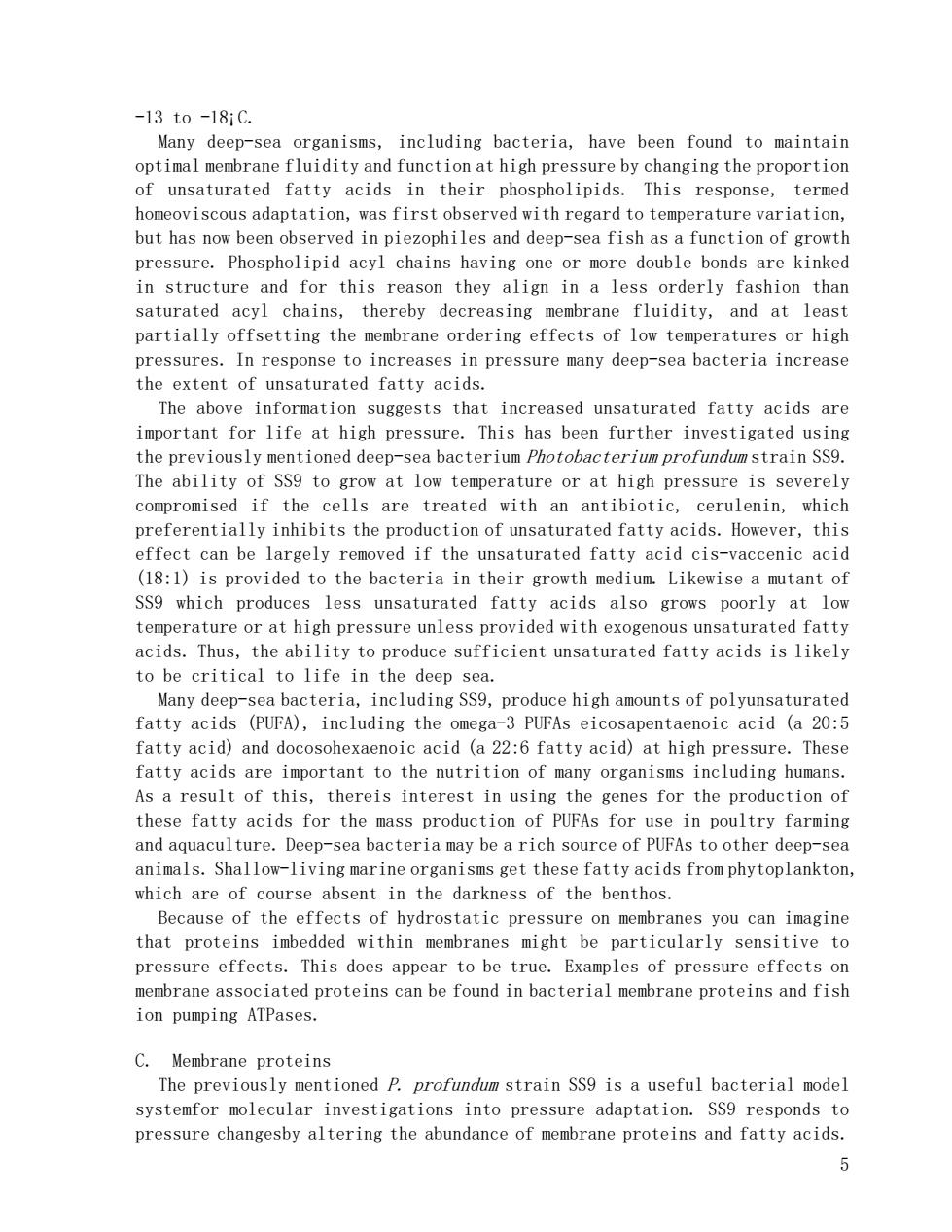
-13to-18iC. Many deep-sea organisms,including bacteria,have been found to maintain optimal membrane fluidity and function at high pressure by changing the proportion of unsaturated fatty acids in their phospholipids.This response,termed homeoviscous adaptation,was first observed with regard to temperature variation, but has now been observed in piezophiles and deep-sea fish as a function of growth pressure.Phospholipid acyl chains having one or more double bonds are kinked in structure and for this reason they align in a less orderly fashion than saturated acyl chains,thereby decreasing membrane fluidity,and at least partially offsetting the membrane ordering effects of low temperatures or high pressures.In response to increases in pressure many deep-sea bacteria increase the extent of unsaturated fatty acids. The above information suggests that increased unsaturated fatty acids are important for life at high pressure.This has been further investigated using the previously mentioned deep-sea bacterium Photobacterium profundum strain SS9. The ability of SS9 to grow at low temperature or at high pressure is severely compromised if the cells are treated with an antibiotic,cerulenin,which preferentially inhibits the production of unsaturated fatty acids.However,this effect can be largely removed if the unsaturated fatty acid cis-vaccenic acid (18:1)is provided to the bacteria in their growth medium.Likewise a mutant of SS9 which produces less unsaturated fatty acids also grows poorly at low temperature or at high pressure unless provided with exogenous unsaturated fatty acids.Thus,the ability to produce sufficient unsaturated fatty acids is likely to be critical to life in the deep sea. Many deep-sea bacteria,including SS9,produce high amounts of polyunsaturated fatty acids (PUFA),including the omega-3 PUFAs eicosapentaenoic acid (a 20:5 fatty acid)and docosohexaenoic acid (a 22:6 fatty acid)at high pressure.These fatty acids are important to the nutrition of many organisms including humans. As a result of this,thereis interest in using the genes for the production of these fatty acids for the mass production of PUFAs for use in poultry farming and aquaculture.Deep-sea bacteria may be a rich source of PUFAs to other deep-sea animals.Shallow-living marine organisms get these fatty acids from phytoplankton, which are of course absent in the darkness of the benthos. Because of the effects of hydrostatic pressure on membranes you can imagine that proteins imbedded within membranes might be particularly sensitive to pressure effects.This does appear to be true.Examples of pressure effects on membrane associated proteins can be found in bacterial membrane proteins and fish ion pumping ATPases. C.Membrane proteins The previously mentioned P.profundum strain SS9 is a useful bacterial model systemfor molecular investigations into pressure adaptation.SS9 responds to pressure changesby altering the abundance of membrane proteins and fatty acids. 5
5 -13 to -18¡C. Many deep-sea organisms, including bacteria, have been found to maintain optimal membrane fluidity and function at high pressure by changing the proportion of unsaturated fatty acids in their phospholipids. This response, termed homeoviscous adaptation, was first observed with regard to temperature variation, but has now been observed in piezophiles and deep-sea fish as a function of growth pressure. Phospholipid acyl chains having one or more double bonds are kinked in structure and for this reason they align in a less orderly fashion than saturated acyl chains, thereby decreasing membrane fluidity, and at least partially offsetting the membrane ordering effects of low temperatures or high pressures. In response to increases in pressure many deep-sea bacteria increase the extent of unsaturated fatty acids. The above information suggests that increased unsaturated fatty acids are important for life at high pressure. This has been further investigated using the previously mentioned deep-sea bacterium Photobacterium profundum strain SS9. The ability of SS9 to grow at low temperature or at high pressure is severely compromised if the cells are treated with an antibiotic, cerulenin, which preferentially inhibits the production of unsaturated fatty acids. However, this effect can be largely removed if the unsaturated fatty acid cis-vaccenic acid (18:1) is provided to the bacteria in their growth medium. Likewise a mutant of SS9 which produces less unsaturated fatty acids also grows poorly at low temperature or at high pressure unless provided with exogenous unsaturated fatty acids. Thus, the ability to produce sufficient unsaturated fatty acids is likely to be critical to life in the deep sea. Many deep-sea bacteria, including SS9, produce high amounts of polyunsaturated fatty acids (PUFA), including the omega-3 PUFAs eicosapentaenoic acid (a 20:5 fatty acid) and docosohexaenoic acid (a 22:6 fatty acid) at high pressure. These fatty acids are important to the nutrition of many organisms including humans. As a result of this, thereis interest in using the genes for the production of these fatty acids for the mass production of PUFAs for use in poultry farming and aquaculture. Deep-sea bacteria may be a rich source of PUFAs to other deep-sea animals. Shallow-living marine organisms get these fatty acids from phytoplankton, which are of course absent in the darkness of the benthos. Because of the effects of hydrostatic pressure on membranes you can imagine that proteins imbedded within membranes might be particularly sensitive to pressure effects. This does appear to be true. Examples of pressure effects on membrane associated proteins can be found in bacterial membrane proteins and fish ion pumping ATPases. C. Membrane proteins The previously mentioned P. profundum strain SS9 is a useful bacterial model systemfor molecular investigations into pressure adaptation. SS9 responds to pressure changesby altering the abundance of membrane proteins and fatty acids

Two outer membrane proteins (OMPs)designated OmpH and OmpL undergo inverse regulation in abundanceas a function of hydrostatic pressure.OmpH is present in high amounts at 28 MPa while OmpL dominates at 0.1 MPa.Both OMPs appear to be nonspecific channel proteins (porins),but OmpH provides for the uptake of larger peptides,a feature which could be important under the low nutrient conditions prevalent in the deep sea.Although neither ompl/nor ompl mutants are impaired in piezophilic growth,some regulatory mutants affecting omp expression in SS9 do influence growth at high pressure. The regulation of OmpH and OmpL is controlled at the transcriptional level by amembrane-localized transcription factor possessing homology to the ToxR regulatory protein from the related species Vibrio cholerae,which functions with an associated protein designated ToxS.As in SS9,V.cholerae ToxR controls the inverse regulation of two omp genes,but unlike SS9 V.cholerae ToxR does not respond to pressure.Thus,the SS9 ToxR protein,which is 50%identical to the V.cholerae homologue,has evolved novel pressure-sensitive properties.The location and structure of ToxR would seem to make it well suited to function as a piezometer for a cell.Membrane fluidity and phase is highly pressure-sensitive and membrane fluidizing treatments can counteract SS9 ToxR high pressure signaling.Another possible site of pressure influence on ToxR is between the interface of its subunits,as well as between ToxR and ToxS.V.cholerae ToxR/S is multimeric and many protein multimers dissociate under moderately high pressure conditions. Slides associated with this lecture: 1.The tree of life has three domains.These are the Bacteria,Archaea and the Eukarya.This basic division of all of life is based on extensive analyses of genes and genomes by evolutionary biologists.In this course we will mostly focus on the members of the Bacteria and Archaea domains. 2.The high pressure portions of the biosphere includes the deep sea and the deep earth,although little is known about deep subsurface life. 3.Introductory slide for deep-sea microbiology. 4.When you examine the bathymetry of our ocean planet you can learn that the average depth of the oceans is 3.8 km.Most of the ocean is within the deep sea. 5.All kinds of interesting organisms exist within the deeper regions of our oceans,such as this blob fish. 6
6 Two outer membrane proteins (OMPs) designated OmpH and OmpL undergo inverse regulation in abundanceas a function of hydrostatic pressure. OmpH is present in high amounts at 28 MPa while OmpL dominates at 0.1 MPa. Both OMPs appear to be nonspecific channel proteins (porins), but OmpH provides for the uptake of larger peptides, a feature which could be important under the low nutrient conditions prevalent in the deep sea. Although neither ompH nor ompL mutants are impaired in piezophilic growth, some regulatory mutants affecting omp expression in SS9 do influence growth at high pressure. The regulation of OmpH and OmpL is controlled at the transcriptional level by amembrane-localized transcription factor possessing homology to the ToxR regulatory protein from the related species Vibrio cholerae, which functions with an associated protein designated ToxS. As in SS9, V. cholerae ToxR controls the inverse regulation of two omp genes, but unlike SS9 V. cholerae ToxR does not respond to pressure. Thus, the SS9 ToxR protein, which is 50% identical to the V. cholerae homologue, has evolved novel pressure-sensitive properties. The location and structure of ToxR would seem to make it well suited to function as a piezometer for a cell. Membrane fluidity and phase is highly pressure-sensitive and membrane fluidizing treatments can counteract SS9 ToxR high pressure signaling. Another possible site of pressure influence on ToxR is between the interface of its subunits, as well as between ToxR and ToxS. V. cholerae ToxR/S is multimeric and many protein multimers dissociate under moderately high pressure conditions. Slides associated with this lecture: 1. The tree of life has three domains. These are the Bacteria, Archaea and the Eukarya. This basic division of all of life is based on extensive analyses of genes and genomes by evolutionary biologists. In this course we will mostly focus on the members of the Bacteria and Archaea domains. 2. The high pressure portions of the biosphere includes the deep sea and the deep earth, although little is known about deep subsurface life. 3. Introductory slide for deep-sea microbiology. 4. When you examine the bathymetry of our ocean planet you can learn that the average depth of the oceans is 3.8 km. Most of the ocean is within the deep sea. 5. All kinds of interesting organisms exist within the deeper regions of our oceans, such as this blob fish
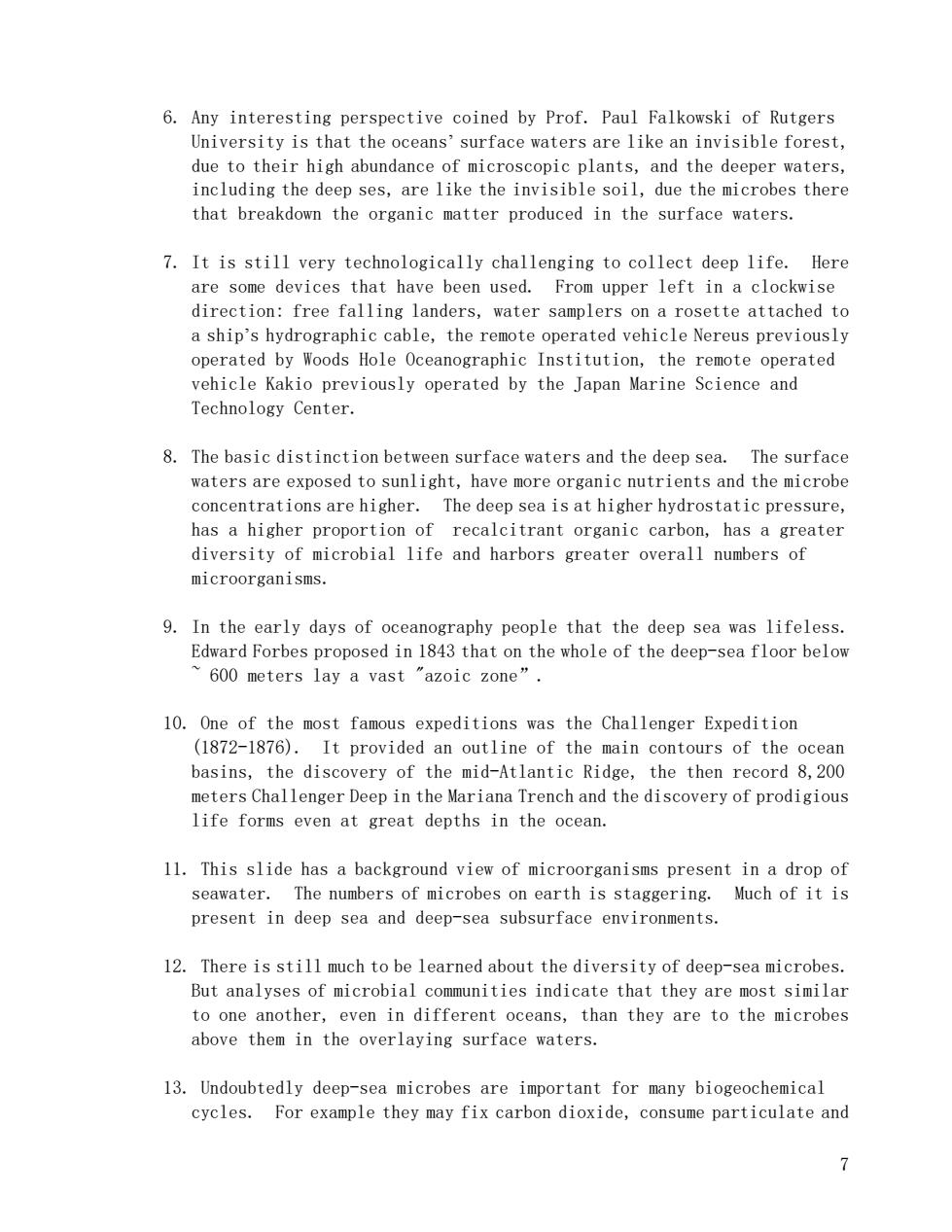
6.Any interesting perspective coined by Prof.Paul Falkowski of Rutgers University is that the oceans'surface waters are like an invisible forest, due to their high abundance of microscopic plants,and the deeper waters, including the deep ses,are like the invisible soil,due the microbes there that breakdown the organic matter produced in the surface waters. 7.It is still very technologically challenging to collect deep life.Here are some devices that have been used.From upper left in a clockwise direction:free falling landers,water samplers on a rosette attached to a ship's hydrographic cable,the remote operated vehicle Nereus previously operated by Woods Hole Oceanographic Institution,the remote operated vehicle Kakio previously operated by the Japan Marine Science and Technology Center. 8.The basic distinction between surface waters and the deep sea.The surface waters are exposed to sunlight,have more organic nutrients and the microbe concentrations are higher.The deep sea is at higher hydrostatic pressure, has a higher proportion of recalcitrant organic carbon,has a greater diversity of microbial life and harbors greater overall numbers of microorganisms. 9.In the early days of oceanography people that the deep sea was lifeless. Edward Forbes proposed in 1843 that on the whole of the deep-sea floor below 600 meters lay a vast "azoic zone". 10.One of the most famous expeditions was the Challenger Expedition (1872-1876).It provided an outline of the main contours of the ocean basins,the discovery of the mid-Atlantic Ridge,the then record 8,200 meters Challenger Deep in the Mariana Trench and the discovery of prodigious life forms even at great depths in the ocean. 11.This slide has a background view of microorganisms present in a drop of seawater.The numbers of microbes on earth is staggering.Much of it is present in deep sea and deep-sea subsurface environments. 12.There is still much to be learned about the diversity of deep-sea microbes. But analyses of microbial communities indicate that they are most similar to one another,even in different oceans,than they are to the microbes above them in the overlaying surface waters. 13.Undoubtedly deep-sea microbes are important for many biogeochemical cycles.For example they may fix carbon dioxide,consume particulate and >
7 6. Any interesting perspective coined by Prof. Paul Falkowski of Rutgers University is that the oceans’ surface waters are like an invisible forest, due to their high abundance of microscopic plants, and the deeper waters, including the deep ses, are like the invisible soil, due the microbes there that breakdown the organic matter produced in the surface waters. 7. It is still very technologically challenging to collect deep life. Here are some devices that have been used. From upper left in a clockwise direction: free falling landers, water samplers on a rosette attached to a ship’s hydrographic cable, the remote operated vehicle Nereus previously operated by Woods Hole Oceanographic Institution, the remote operated vehicle Kakio previously operated by the Japan Marine Science and Technology Center. 8. The basic distinction between surface waters and the deep sea. The surface waters are exposed to sunlight, have more organic nutrients and the microbe concentrations are higher. The deep sea is at higher hydrostatic pressure, has a higher proportion of recalcitrant organic carbon, has a greater diversity of microbial life and harbors greater overall numbers of microorganisms. 9. In the early days of oceanography people that the deep sea was lifeless. Edward Forbes proposed in 1843 that on the whole of the deep-sea floor below ~ 600 meters lay a vast "azoic zone”. 10. One of the most famous expeditions was the Challenger Expedition (1872-1876). It provided an outline of the main contours of the ocean basins, the discovery of the mid-Atlantic Ridge, the then record 8,200 meters Challenger Deep in the Mariana Trench and the discovery of prodigious life forms even at great depths in the ocean. 11. This slide has a background view of microorganisms present in a drop of seawater. The numbers of microbes on earth is staggering. Much of it is present in deep sea and deep-sea subsurface environments. 12. There is still much to be learned about the diversity of deep-sea microbes. But analyses of microbial communities indicate that they are most similar to one another, even in different oceans, than they are to the microbes above them in the overlaying surface waters. 13. Undoubtedly deep-sea microbes are important for many biogeochemical cycles. For example they may fix carbon dioxide, consume particulate and
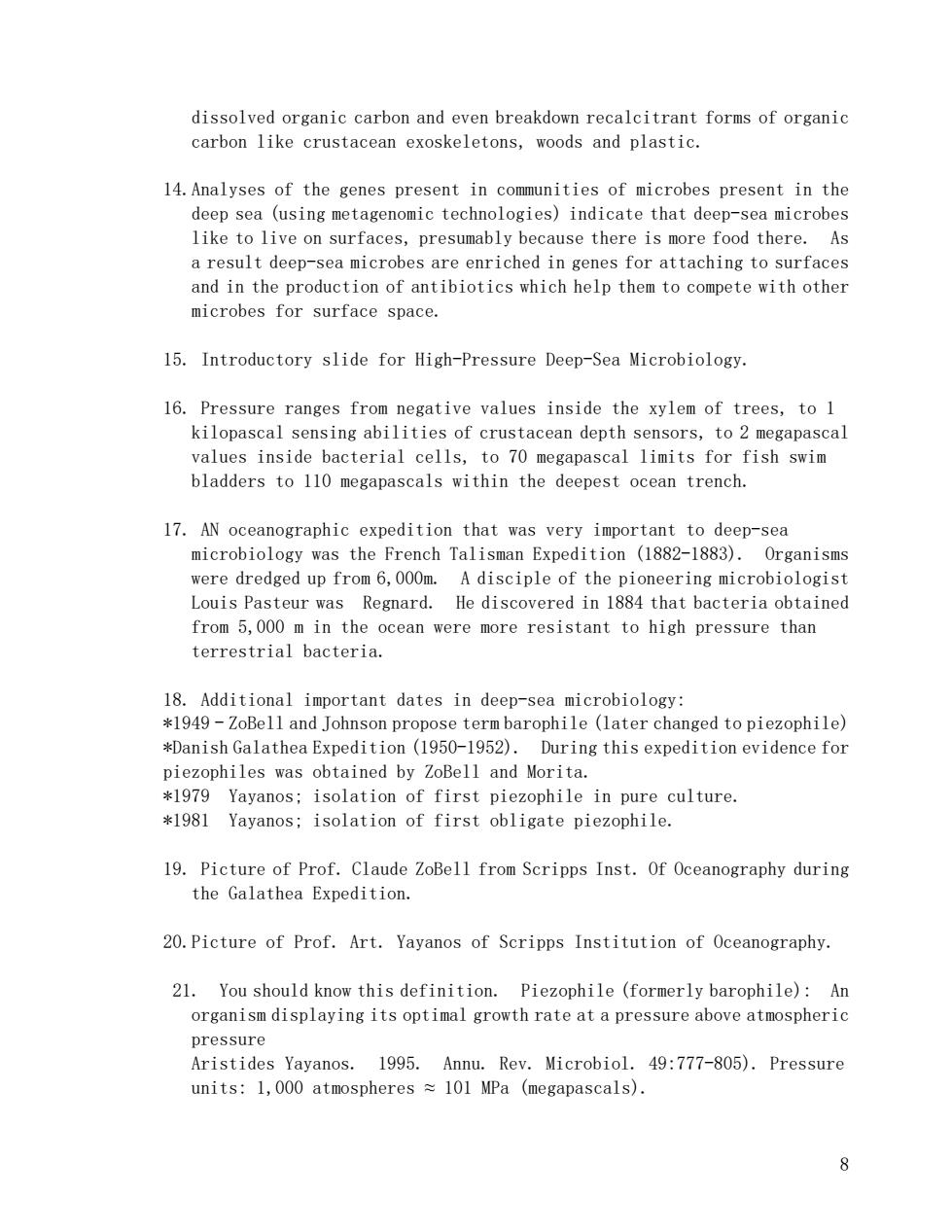
dissolved organic carbon and even breakdown recalcitrant forms of organic carbon like crustacean exoskeletons,woods and plastic. 14.Analyses of the genes present in communities of microbes present in the deep sea (using metagenomic technologies)indicate that deep-sea microbes like to live on surfaces,presumably because there is more food there.As a result deep-sea microbes are enriched in genes for attaching to surfaces and in the production of antibiotics which help them to compete with other microbes for surface space. 15.Introductory slide for High-Pressure Deep-Sea Microbiology. 16.Pressure ranges from negative values inside the xylem of trees,to 1 kilopascal sensing abilities of crustacean depth sensors,to 2 megapascal values inside bacterial cells,to 70 megapascal limits for fish swim bladders to 110 megapascals within the deepest ocean trench. 17.AN oceanographic expedition that was very important to deep-sea microbiology was the French Talisman Expedition (1882-1883).Organisms were dredged up from 6,000m.A disciple of the pioneering microbiologist Louis Pasteur was Regnard.He discovered in 1884 that bacteria obtained from 5,000 m in the ocean were more resistant to high pressure than terrestrial bacteria. 18.Additional important dates in deep-sea microbiology: *1949-ZoBell and Johnson propose term barophile (later changed to piezophile) *Danish Galathea Expedition(1950-1952).During this expedition evidence for piezophiles was obtained by ZoBell and Morita. *1979 Yayanos;isolation of first piezophile in pure culture. *1981 Yayanos;isolation of first obligate piezophile. 19.Picture of Prof.Claude ZoBell from Scripps Inst.Of Oceanography during the Galathea Expedition. 20.Picture of Prof.Art.Yayanos of Scripps Institution of Oceanography. 21.You should know this definition.Piezophile (formerly barophile):An organism displaying its optimal growth rate at a pressure above atmospheric pressure Aristides Yayanos.1995.Annu.Rev.Microbiol.49:777-805).Pressure units:1,000 atmospheres 101 MPa (megapascals). P
8 dissolved organic carbon and even breakdown recalcitrant forms of organic carbon like crustacean exoskeletons, woods and plastic. 14.Analyses of the genes present in communities of microbes present in the deep sea (using metagenomic technologies) indicate that deep-sea microbes like to live on surfaces, presumably because there is more food there. As a result deep-sea microbes are enriched in genes for attaching to surfaces and in the production of antibiotics which help them to compete with other microbes for surface space. 15. Introductory slide for High-Pressure Deep-Sea Microbiology. 16. Pressure ranges from negative values inside the xylem of trees, to 1 kilopascal sensing abilities of crustacean depth sensors, to 2 megapascal values inside bacterial cells, to 70 megapascal limits for fish swim bladders to 110 megapascals within the deepest ocean trench. 17. AN oceanographic expedition that was very important to deep-sea microbiology was the French Talisman Expedition (1882-1883). Organisms were dredged up from 6,000m. A disciple of the pioneering microbiologist Louis Pasteur was Regnard. He discovered in 1884 that bacteria obtained from 5,000 m in the ocean were more resistant to high pressure than terrestrial bacteria. 18. Additional important dates in deep-sea microbiology: *1949 - ZoBell and Johnson propose term barophile (later changed to piezophile) *Danish Galathea Expedition (1950-1952). During this expedition evidence for piezophiles was obtained by ZoBell and Morita. *1979 Yayanos; isolation of first piezophile in pure culture. *1981 Yayanos; isolation of first obligate piezophile. 19. Picture of Prof. Claude ZoBell from Scripps Inst. Of Oceanography during the Galathea Expedition. 20.Picture of Prof. Art. Yayanos of Scripps Institution of Oceanography. 21. You should know this definition. Piezophile (formerly barophile): An organism displaying its optimal growth rate at a pressure above atmospheric pressure Aristides Yayanos. 1995. Annu. Rev. Microbiol. 49:777-805). Pressure units: 1,000 atmospheres ≈ 101 MPa (megapascals)
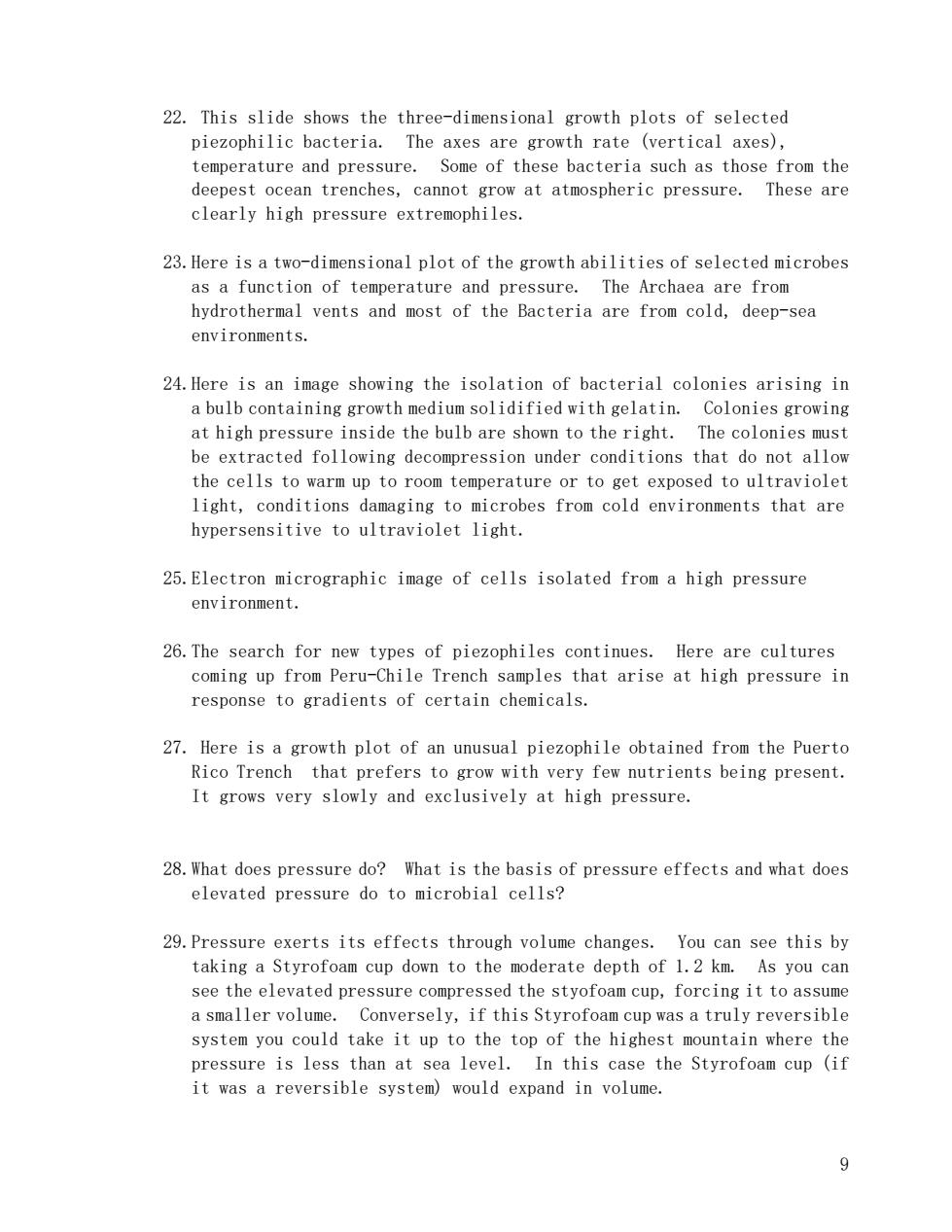
22.This slide shows the three-dimensional growth plots of selected piezophilic bacteria.The axes are growth rate (vertical axes), temperature and pressure.Some of these bacteria such as those from the deepest ocean trenches,cannot grow at atmospheric pressure.These are clearly high pressure extremophiles. 23.Here is a two-dimensional plot of the growth abilities of selected microbes as a function of temperature and pressure.The Archaea are from hydrothermal vents and most of the Bacteria are from cold,deep-sea environments. 24.Here is an image showing the isolation of bacterial colonies arising in a bulb containing growth medium solidified with gelatin.Colonies growing at high pressure inside the bulb are shown to the right.The colonies must be extracted following decompression under conditions that do not allow the cells to warm up to room temperature or to get exposed to ultraviolet light,conditions damaging to microbes from cold environments that are hypersensitive to ultraviolet light. 25.Electron micrographic image of cells isolated from a high pressure environment. 26.The search for new types of piezophiles continues.Here are cultures coming up from Peru-Chile Trench samples that arise at high pressure in response to gradients of certain chemicals. 27.Here is a growth plot of an unusual piezophile obtained from the Puerto Rico Trench that prefers to grow with very few nutrients being present. It grows very slowly and exclusively at high pressure. 28.What does pressure do?What is the basis of pressure effects and what does elevated pressure do to microbial cells? 29.Pressure exerts its effects through volume changes.You can see this by taking a Styrofoam cup down to the moderate depth of 1.2 km.As you can see the elevated pressure compressed the styofoam cup,forcing it to assume a smaller volume.Conversely,if this Styrofoam cup was a truly reversible system you could take it up to the top of the highest mountain where the pressure is less than at sea level.In this case the Styrofoam cup (if it was a reversible system)would expand in volume. 9
9 22. This slide shows the three-dimensional growth plots of selected piezophilic bacteria. The axes are growth rate (vertical axes), temperature and pressure. Some of these bacteria such as those from the deepest ocean trenches, cannot grow at atmospheric pressure. These are clearly high pressure extremophiles. 23.Here is a two-dimensional plot of the growth abilities of selected microbes as a function of temperature and pressure. The Archaea are from hydrothermal vents and most of the Bacteria are from cold, deep-sea environments. 24.Here is an image showing the isolation of bacterial colonies arising in a bulb containing growth medium solidified with gelatin. Colonies growing at high pressure inside the bulb are shown to the right. The colonies must be extracted following decompression under conditions that do not allow the cells to warm up to room temperature or to get exposed to ultraviolet light, conditions damaging to microbes from cold environments that are hypersensitive to ultraviolet light. 25.Electron micrographic image of cells isolated from a high pressure environment. 26.The search for new types of piezophiles continues. Here are cultures coming up from Peru-Chile Trench samples that arise at high pressure in response to gradients of certain chemicals. 27. Here is a growth plot of an unusual piezophile obtained from the Puerto Rico Trench that prefers to grow with very few nutrients being present. It grows very slowly and exclusively at high pressure. 28.What does pressure do? What is the basis of pressure effects and what does elevated pressure do to microbial cells? 29.Pressure exerts its effects through volume changes. You can see this by taking a Styrofoam cup down to the moderate depth of 1.2 km. As you can see the elevated pressure compressed the styofoam cup, forcing it to assume a smaller volume. Conversely, if this Styrofoam cup was a truly reversible system you could take it up to the top of the highest mountain where the pressure is less than at sea level. In this case the Styrofoam cup (if it was a reversible system) would expand in volume
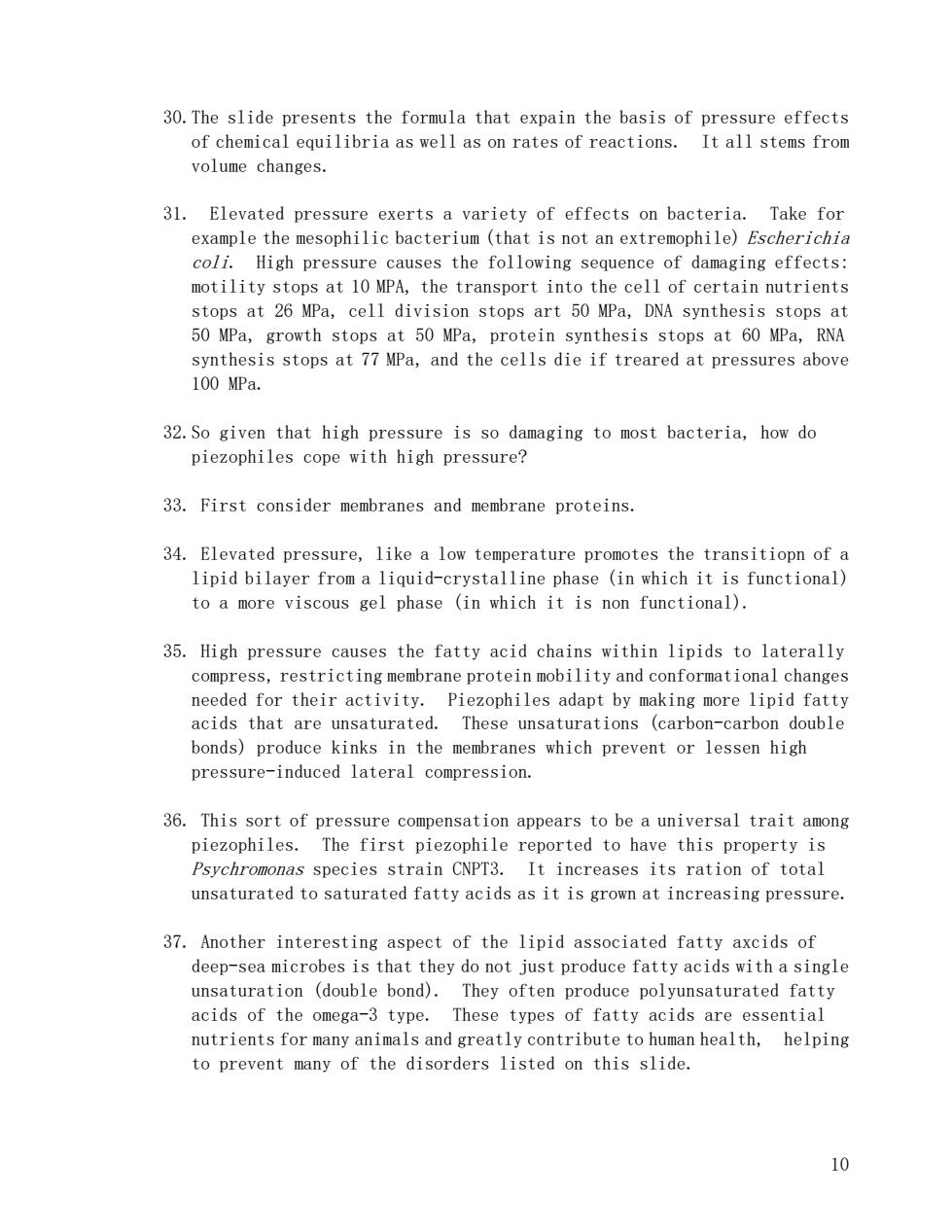
30.The slide presents the formula that expain the basis of pressure effects of chemical equilibria as well as on rates of reactions.It all stems from volume changes. 31.Elevated pressure exerts a variety of effects on bacteria.Take for example the mesophilic bacterium (that is not an extremophile)Escherichia coli.High pressure causes the following sequence of damaging effects: motility stops at 10 MPA,the transport into the cell of certain nutrients stops at 26 MPa,cell division stops art 50 MPa,DNA synthesis stops at 50 MPa,growth stops at 50 MPa,protein synthesis stops at 60 MPa,RNA synthesis stops at 77 MPa,and the cells die if treared at pressures above 100 MPa. 32.So given that high pressure is so damaging to most bacteria,how do piezophiles cope with high pressure? 33.First consider membranes and membrane proteins. 34.Elevated pressure,like a low temperature promotes the transitiopn of a lipid bilayer from a liquid-crystalline phase (in which it is functional) to a more viscous gel phase (in which it is non functional). 35.High pressure causes the fatty acid chains within lipids to laterally compress,restricting membrane protein mobility and conformational changes needed for their activity.Piezophiles adapt by making more lipid fatty acids that are unsaturated.These unsaturations (carbon-carbon double bonds)produce kinks in the membranes which prevent or lessen high pressure-induced lateral compression. 36.This sort of pressure compensation appears to be a universal trait among piezophiles.The first piezophile reported to have this property is Psychromonas species strain CNPT3.It increases its ration of total unsaturated to saturated fatty acids as it is grown at increasing pressure. 37.Another interesting aspect of the lipid associated fatty axcids of deep-sea microbes is that they do not just produce fatty acids with a single unsaturation (double bond).They often produce polyunsaturated fatty acids of the omega-3 type.These types of fatty acids are essential nutrients for many animals and greatly contribute to human health,helping to prevent many of the disorders listed on this slide. 10
10 30.The slide presents the formula that expain the basis of pressure effects of chemical equilibria as well as on rates of reactions. It all stems from volume changes. 31. Elevated pressure exerts a variety of effects on bacteria. Take for example the mesophilic bacterium (that is not an extremophile) Escherichia coli. High pressure causes the following sequence of damaging effects: motility stops at 10 MPA, the transport into the cell of certain nutrients stops at 26 MPa, cell division stops art 50 MPa, DNA synthesis stops at 50 MPa, growth stops at 50 MPa, protein synthesis stops at 60 MPa, RNA synthesis stops at 77 MPa, and the cells die if treared at pressures above 100 MPa. 32.So given that high pressure is so damaging to most bacteria, how do piezophiles cope with high pressure? 33. First consider membranes and membrane proteins. 34. Elevated pressure, like a low temperature promotes the transitiopn of a lipid bilayer from a liquid-crystalline phase (in which it is functional) to a more viscous gel phase (in which it is non functional). 35. High pressure causes the fatty acid chains within lipids to laterally compress, restricting membrane protein mobility and conformational changes needed for their activity. Piezophiles adapt by making more lipid fatty acids that are unsaturated. These unsaturations (carbon-carbon double bonds) produce kinks in the membranes which prevent or lessen high pressure-induced lateral compression. 36. This sort of pressure compensation appears to be a universal trait among piezophiles. The first piezophile reported to have this property is Psychromonas species strain CNPT3. It increases its ration of total unsaturated to saturated fatty acids as it is grown at increasing pressure. 37. Another interesting aspect of the lipid associated fatty axcids of deep-sea microbes is that they do not just produce fatty acids with a single unsaturation (double bond). They often produce polyunsaturated fatty acids of the omega-3 type. These types of fatty acids are essential nutrients for many animals and greatly contribute to human health, helping to prevent many of the disorders listed on this slide